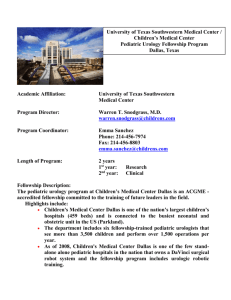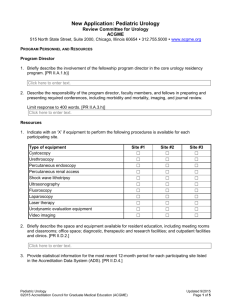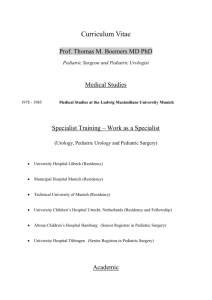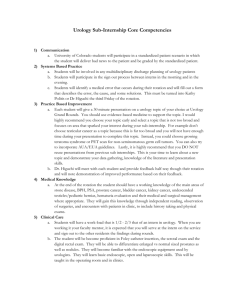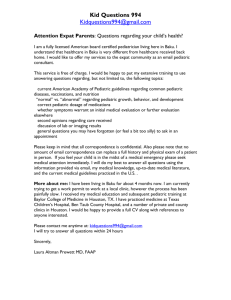Pediatric Residency Program Template
advertisement
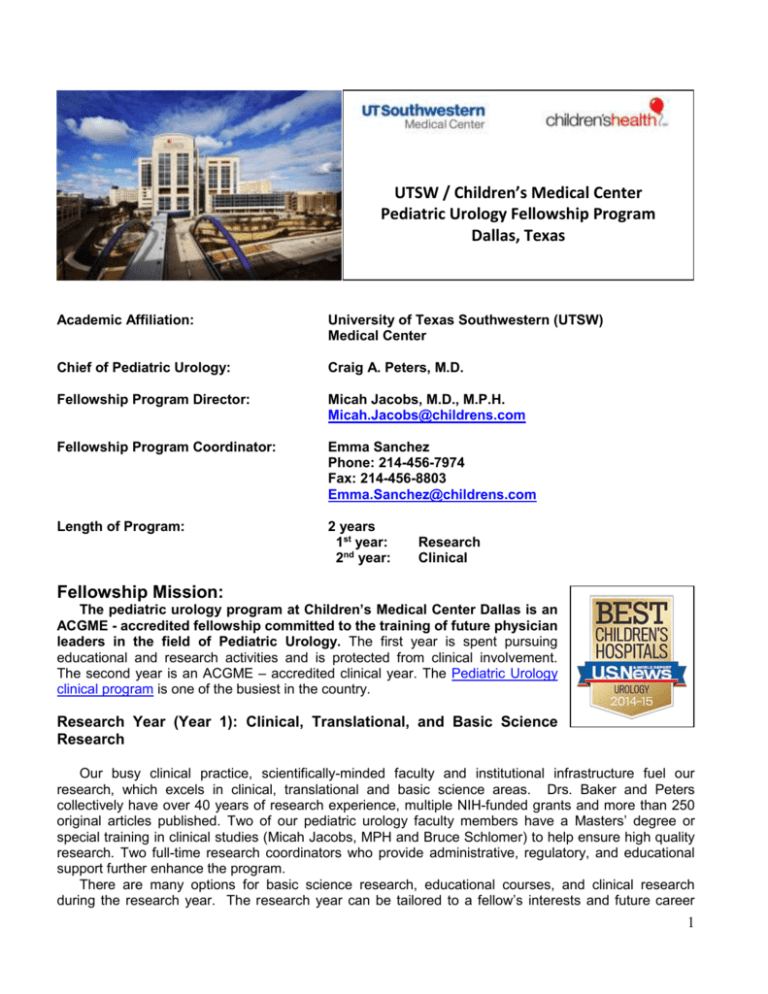
UTSW / Children’s Medical Center Pediatric Urology Fellowship Program Dallas, Texas Academic Affiliation: University of Texas Southwestern (UTSW) Medical Center Chief of Pediatric Urology: Craig A. Peters, M.D. Fellowship Program Director: Micah Jacobs, M.D., M.P.H. Micah.Jacobs@childrens.com Fellowship Program Coordinator: Emma Sanchez Phone: 214-456-7974 Fax: 214-456-8803 Emma.Sanchez@childrens.com Length of Program: 2 years 1st year: 2nd year: Research Clinical Fellowship Mission: The pediatric urology program at Children’s Medical Center Dallas is an ACGME - accredited fellowship committed to the training of future physician leaders in the field of Pediatric Urology. The first year is spent pursuing educational and research activities and is protected from clinical involvement. The second year is an ACGME – accredited clinical year. The Pediatric Urology clinical program is one of the busiest in the country. Research Year (Year 1): Clinical, Translational, and Basic Science Research Our busy clinical practice, scientifically-minded faculty and institutional infrastructure fuel our research, which excels in clinical, translational and basic science areas. Drs. Baker and Peters collectively have over 40 years of research experience, multiple NIH-funded grants and more than 250 original articles published. Two of our pediatric urology faculty members have a Masters’ degree or special training in clinical studies (Micah Jacobs, MPH and Bruce Schlomer) to help ensure high quality research. Two full-time research coordinators who provide administrative, regulatory, and educational support further enhance the program. There are many options for basic science research, educational courses, and clinical research during the research year. The research year can be tailored to a fellow’s interests and future career 1 plans. The research year is protected from clinical duties and no call is required. Fellows are not expected to find any salary funding for the research year. All fellows have produced multiple publications and abstract presentations from work performed in the fellowship. (see table below) Basic Science Research Facilities The Division of Pediatric Urology includes the John Patients Duckett Pediatric Urology Laboratory, directed by Dr. Linda Baker. This endowed research laboratory focuses upon human subjects genetic studies and genetically engineered mutant mouse models of pediatric urologic Faculty birth defects and diseases and has recently been Research awarded another NIH grant. The lab is involved in multiple collaborative efforts within the UT Southwestern system, home to more Nobel Laureates than any other US institution. Cutting–edge genomic research is performed, employing comparative genomic hybridization, SNP microarrays, whole exome sequencing and other technologies to identify genetic causes of pediatric urologic disorders. (http://www.utsouthwestern.edu/labs/baker/) Educational Courses There is ample opportunity for fellows to participate, initiate, and become educated in research, thereby making us better pediatric urologists. Our Fellows can audit or take didactic courses for credit towards a certificate or master’s degree, taught by faculty of the top-ranked Center for Translational Medicine and Department of Clinical Sciences at the University of Texas Southwestern Medical Center. This coursework provides training in clinical research design and analysis, protocol design, epidemiology, outcomes research, development and validation of research tools, biostatistics, and grant writing. This is truly an outstanding educational opportunity for our fellows to better our specialty of pediatric urology as a whole. Clinical Research Over 30 IRB approved study protocols are underway, covering essentially every topic in pediatric urology via prospective or retrospective designs (see table). The quality of research we perform is nationally recognized. Currently, we are performing a large NIH-funded to study rare genomic variants of Prune Belly Syndrome, (NIH 1R01DK105068-01; Baker, PI). We have two research coordinators exclusively dedicated to our pediatric urology studies. Thus, the infrastructure for a very productive year in research exists. In addition, all fellows are invited to travel to both the AUA spring meeting and the Pediatric Urology Fall Congress during both years of their fellowship. PEDIATRIC UROLOGY STUDIES UNDERWAY AT UT SOUTHWESTERN AND CHILDREN’S MEDICAL CENTER (Selected) Advanced Applications of Robotic Surgery to Pediatric Urology Clinical Outcomes and Molecular Characterization of Autologous Buccal Mucosa Vaginoplasty Management and Genetic Basis of Pediatric Urolithiasis Genetic Basis of Prune Belly Syndrome & other rare Pediatric GU Anomalies (NIH funded) Near-Infrared Spectroscopy for Pediatric Acute Scrotum (NIH funded) Transitional Care of Young Adults with Spina Bifida and Exstrophy Etiology of Cryptorchidism and Hypospadias Management of Spina Bifida Genetic Causes for Disorders of Sex Development 2 Medical/Surgical Mission Work Dr. Clanton Harrison is a member of LEAP Global Missions, a mission organization that travels to Haiti twice a year to provide essential medical and surgical services to the children of extreme poverty. Fellows are provided the opportunity to travel with the organization on a voluntary basis. The trip provides humanitarian medical and surgical care to children in need, teaching and infrastructure support to the local health care providers, a clinical and operative experience to our fellows, and an invaluable personal experience. Clinical Program (Year 2) Every aspect of Pediatric Urology is found in our clinical program, including complex open urinary tract reconstruction, robotic and laparoscopic surgery, stone disease management, complex hypospadias surgery, disorders of sexual development management, and vaginal reconstruction. Fellows obtain ample experience in rare and complex reconstruction as well as “bread and butter” pediatric urology for a very well rounded clinical experience. Fellows are expected to be the leader of a clinical trainee team that includes a 3rd year and a 4th year urology resident from UTSW as well as rotating UTSW or visiting medical students. On-call time is one weekday a week and one weekend a month. All call is back-up call to a 3rd or 4th year UTSW urology resident. Clinical Facilities As the flagship facility of the Children’s Health System Texas, Children's Medical Center Dallas is one of the nation’s largest children’s hospitals (490 beds; 112 ICU beds; 32 Operating rooms-24 inpatient/8 outpatient) and is connected to the busiest neonatal and obstetric unit in the US Parkland Hospital. In addition to the main Children’s campus, we utilize Children’s Legacy Plano (a smaller inpatient hospital (72 beds) where ambulatory surgeries are performed), and we have 6 sites for outpatient clinics. With a population of ~7 million in the DFW metroplex and a catchment area including all of North Texas and some adjacent states, the case volume and complexity is high. Our group sees more than 7,400 children in outpatient clinic visits and performs ~1,800 operations per year including some of the highest numbers of robotic surgeries in the country for a pediatric urology program. 3 Our fellowship provides intensive experience in neurogenic bladder management and reconstruction via our services at Texas Scottish Rite Hospital (TSRH). Every Tuesday afternoon, there is a clinic at TSRH that is staffed by our faculty and dedicated to the urologic care of children with spina bifida and other causes of neurogenic bladder. Annually we provide pediatric urology care for >500 spina bifida or spinal cord injury urologic patients at TSRH, which is one of the largest SB/SCI programs in the US. Clinical Programs The pediatric urology division provides care for many complex patients and has the following specialty programs: Comprehensive Stone Program Spina Bifida Program Disorders of Sexual Development Clinic Program for Rare Genitourinary Birth Defects and Disorders Prenatal Evaluation Program Center for Vaginal Reconstruction and Female Genitourinary Reconstructive Surgery Minimally Invasive and Robotic Surgery Program Center for Voiding Dysfunction Conferences The pediatric urology program includes 2 weekly conferences, the preoperative conference and a weekly rotating conference. Weekly preoperative conference (1 hour) Rotating weekly didactic conferences (1 hour) Disorders of Sex Development Radiology GI/GU Multidisciplinary Conference Tumor Board/ Multi-disciplinary Oncology conference Pathology Morbidity and Mortality Journal Club Nephrology/Transplant Research Meeting Pediatric Urology Faculty Our pediatric urology faculty consists of five fellowship-trained pediatric urologists and 3 pediatric urology nurse practitioners. Craig A. Peters, M.D., Chief of Pediatric Urology Linda Baker, MD, Director of Pediatric Urology Research o John Duckett Laboratory Clanton Harrison, MD Micah Jacobs, MD, MPH, Pediatric Urology Fellowship Program Director Bruce Schlomer, MD 4 Karen Pritzker, RN, MSN, CPNP Janelle Traylor, RN, MSN, APRN Jennifer Tracy, RN, MSN, CPNP Pediatric Urology Fellowship: History: Our ACGME accredited fellowship began in 2005. A total of 10 fellows have completed the program and all fellowship spots are currently taken. Past and current fellows include: Year of Fellowship 2018 2017 2016 2015 Name of Fellow Matthew Timberlake Adam Kern Vani Menon Gwen Grimsby 2014 Mélise Keays 2013 2012 2011 2010 2009 Carlos Villaneuva Candace Granberg Daniel DaJusta Theodore Barber Nicol Bush 2008 Juan C. Prieto 2007 Ali Ziada 2006 Selcuk Yucel After Graduation Mayo Clinic, Phoenix, AZ Children’s Hospital of Eastern Ontario, Ottawa, Ontario, CANADA University of Nebraska, Omaha, NE Mayo Clinic, Rochester, MN Nationwide Children’s, Columbus, OH Urologic Consultants, Grand Rapids, MI Parc Urology, Frisco, TX Methodist Children's Hospital San Antonio, TX Dept of Urology, University of Kentucky College of Medicine, Lexington, KY Dept of Urology, Akdeniz University School of Medicine, Antalya, TURKEY How to apply: We participate in the national match. All applicants should complete the Universal Pediatric Urology Fellowship Application which can be found at http://spuonline.org and forward three letters of recommendation, including one from the department chair, to emma.sanchez@childrens.com The deadline for applications each year will be early March. Why Dallas? Dallas is the 9th largest city in the United States. Dallas is also surrounded by many great suburbs and townships, such as Uptown, University Park, Highland Park, Addison, Allen, Las Colinas, Denton and Richardson, many of which have their own homey downtowns, beautiful parks, such as the Klyde Warren Park and seasonal events (like Oktoberfest). An hour drive from Fort Worth, one 5 can also take the Trinity Railroad Express (TRE) to and from Fort Worth and Dallas to visit the Fort Worth Stockyards. There is never a lack of things to do. The Dallas World Aquarium is astoundingly beautiful, and the Dallas Zoo has expanded quite extensively over the past few years. Dallas has had a small boom in breweries, such as Community Brewery downtown. The Dallas Museum of Art makes for a great day trip, and historical downtown is always interesting territory to explore, not to mention the newly built Perot Museum of Nature and Science. Home to the Dallas Cowboys, Dallas Mavericks, Dallas Stars, and the Texas Rangers, there is always a game to catch. Don’t forget about the Texas State Fair during the Fall. Street Art in Dallas - Dallas Fun Facts: • The frozen margarita machine was invented in Dallas • The integrated circuit computer chip (which became the microchip) was invented in Dallas in 1958 • The 52 foot 'Big Tex' statue that greets visitors at the annual State Fair of Texas is the tallest cowboy in Texas. • With the roof closed, the entire Statue of Liberty could fit into the Cowboys Stadium. • During the winter holiday season, the Galleria Dallas is home to the country's tallest indoor Christmas tree. • The largest permanent model train exhibit in the country is on display in the lobby of Dallas Children's Medical Center. • The Dallas Arts District is the largest urban arts district in the United States. • The Trinity River Corridor Project, when completed, will be more than 10 times the size of New York's Central Park. • Highland Park Village Shopping Center, developed in 1931 has the distinction of being the first planned shopping center in America. • The first convenience store, 7-eleven, got its start in Dallas and the corporation is headquartered there today. • A few celebrities from the area: Angie Harmon, Luke and Owen Wilson, Nastia Luikin, Lee Trevino, Norah Jones, Erykah Badu, Jessica Simpson • A few of the movies/TV series filmed in the area: Dallas; Silkwood; Places in the Heart; RoboCop; Born on the Fourth of July; Walker, Texas Ranger; Prison Break (more listed at http://www.dallasfilmcommission.com/) • The Dallas area is the largest metropolitan area in the nation not on a navigable body of water. • The Dallas-Fort Worth Arlington Metroplex is the No. 1 visitor and leisure destination in Texas. 6 • • The Dallas Public Library permanently displays one of the original copies of the Declaration of Independence, printed on July 4, 1776, and the First Folio of William Shakespeare's "Comedies, Histories & Tragedies." The Dallas/Fort Worth Metroplex is home to 23 of the richest Americans. 7
